2.9: Even more Haplorhines (The Apes)
- Last updated
- Save as PDF
- Page ID
- 4974
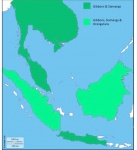
Figure \(\PageIndex{1}\) - Distribution of gibbons, siamangs, and orangutans. Original blank map from http://d-maps.com/pays.php?num_pay=67&lang=en modified to show distibution of the Southeast Asian great apes.
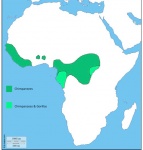
Figure \(\PageIndex{2}\) - Distribution of chimpanzees and gorillas. Original blank map from http://d-maps.com/carte.php?num_car=728&lang=en modified to show the distribution of the African great apes.
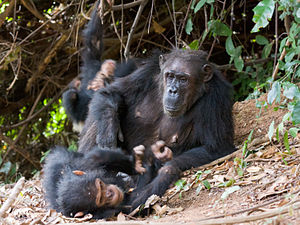
Figure \(\PageIndex{3}\) - Chimpanzee (Pan troglodytes) female and offspring
All apes are members of the superfamily Hominoidea; sometimes they are called hominoids. Hominoids are divided into two families: Hylobatidae, the lesser apes, and Hominidae, the great apes. The Hominids are further divided into three subfamilies: Ponginae, Gorillinae, and Homininae, the latter of which is comprised of two tribes: Panini and Hominini. Which apes belong to each of the classifications will be discussed below.
Common Characteristics
Apes share some common characteristics; note these are in comparison to other primates (Jurmain et al. 2013: 142):
- Generally larger body size
- No tail
- Lower back is shorter and more stable
- Arms longer than legs (except for humans)
- Anatomical differences in shoulder joint that facilitate suspensory feeding and locomotion
- Generally more complex behavior
- More complex brain and enhanced cognitive abilities
- Increased period of infant development and dependency
Hylobatidae

Figure \(\PageIndex{4}\) - Siamang (Symphalangus syndactylus)

Figure \(\PageIndex{5}\) - Female and male white-browed gibbons (Hoolock hoolock)
There is one genera of hylobatids,Hylobates and four subgenera: 1) Bunopithecus, e.g., Western hoolock gibbon, 2) Hylobates, e.g., white-handed gibbon and Bornean white-bearded gibbon, 3) Symphalangus, i.e., siamang, and 4) Nomascus, e.g., black crested gibbon and yellow-cheeked gibbon, many of which are endangered or critically endangered. They are the smallest of the apes, which is why they are sometimes called the “lesser” apes. Hylobatids rarely spend time on the ground. Because they venture so infrequently to the ground they do not have to contend with predators. “Their lifestyle has enabled them to remain petite and agile” (Hamilton 20062: 222). They are true brachiators. Their arms are much longer than their legs and the thumb is attached to the wrist instead of the palm. This enables them to use their hands as hooks as they swing through the trees. They can move quite fast as their arm span allows them to swing over nine feet in a single movement and they can leap up to almost 30 feet in a single bound (Hamilton 20062). While feeding, hylobatids will use quadrumanous, or four-footed, climbing.
Like some Old World monkeys, hylobatids have ischial callosities, which are for sitting while sleeping (if they do not sit while sleeping, they curl up on their side). They are the only non-human ape that does not build a nest for sleeping. They are well-known for their vocalizations. Monogamous pairs will sing in the morning and evening. The calls can travel over half-a-mile and are used “for territorial defense, maintenance of the pair bond, and general communication” (Paciulli and Neary 2006: 1079). Gibbons may call out 80 to 90% of the day while siamangs only vocalize about 30% of the day. Check out the hylobatids sound gallery from the Gibbons Research Gallery to listen to various vocalizations: http://www.gibbons.de/main/sound.html.
The hylobatids exhibit some sexual dimorphism. They exhibit various colorations as well. For example, female white-browed gibbons (H. hoolock) are tan while the males are black; a condition referred to as sexual dichromatism, which means that males and females are different colors. Other species have various color fur, e.g., the silvery gibbon has a silver coat while the Kloss gibbon has a black coat and the Mueller’s Bornean gibbon is gray although there is no variation in color between males and females.
Hylobatids are frugivores, although they will eat leaves, flowers and small invertebrates as well. As mentioned previously, they are monogamous and live with their offspring, who may stay with their parents for up to ten years. At some point, offspring “bud off,” or take over part of their parents territory and start their own family groups. Families defend their territories, using vocalizations, chasing, and theatrics such as stick breaking and trashing vegetation; rarely are confrontations physical.
Hominidae

Figure \(\PageIndex{6}\) - Baby bonobo (Pan paniscus)
Orangutans, gorilla, chimpanzees, bonobos, and humans comprise the family Hominidae. Humans will not be covered in this section as Unit 3 is entirely about human evolution. The great apes are the largest primates, with the male eastern lowland gorilla weighing up to 450 pounds. There is extreme sexual dimorphism among orangutans and gorillas; less so in chimpanzees and bonobos. All are quadrupedal, although there are some differences in how quadrupedalism manifests itself. Orangutans exhibit quadrumanous scrambling when arboreal and fist-walking terrestrially while chimpanzees and gorillas are knuckle-walkers. Bonobos also exhibit frequent bipedalism.
Ponginae
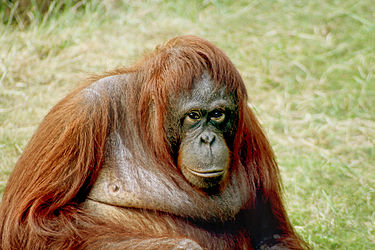
Figure \(\PageIndex{7}\) - Bornean orangutan (Pongo pygmaeus)
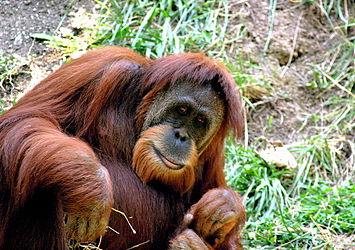
Figure \(\PageIndex{8}\) - Sumatran orangutan (Pongo abelii)
Both species of pongids are critically endangered: Pongo pygmaeus, the Bornean orangutan, and Pongo abelii, the Sumatran orangutan with dark maroon hair and figure-eight-shaped, hairless faces. Bornean orangutans have ginger-colored hair with light hair on their elongated oval-shaped faces. Bornean orangutans are smaller and fatter than the Sumartran orangs. Second in size only to gorillas, orangutans exhibit sexual dimorphism with the adult males weighing up to 200 pounds with adult females about half that. Mature males have cheek flanges (the bigger the cheek flanges the better as females choose mates based on cheek flange size) and throat pouches with which they make booming calls that alert male rivals and females of their presence. They also have beards and mustaches (Sumatran orangs have longer facial hair than the Bornean orangs). Sexually mature (but not fully grown) males, and occasionally a flanged male, have been known to try to mate with unwilling females, a behavior human researchers have referred to as attempted rape. A study of Sumatran orangs suggests that this is a successful breeding strategy for the unflanged males who sired as many offspring as flanged males without the stress of competing with a fully mature flanged male in an overlapping home range.

Figure \(\PageIndex{9}\) - Fully mature male Bornean orangutan (Pongo pygmaeus)
Orangutans are solitary primates with males and females coming together only to mate. Females may temporarily socialize with other females, but generally live only with one or two of their offspring. Females usually have one offspring at a time with birth spacing of at least six years. Of the non-human apes, female orangs have the longest period of parental investment, lasting up to ten years. Primatologists suggest that this long period of childcare is so that the young have sufficient time to learn “the complexities of life in the rain forest” (Groves 2006: 1787). Like the hylobatids, orangs spend the majority of their time in trees. Since they weigh too much to walk across tree branches to get to another tree, they return to the ground and walk to the next tree. Sumatran orangutans spend less time on the ground than their Bornean counterparts because they are subject to predators such as tigers and cloud leopards whereas the Bornean orangs do not have the same concern.
Orangutans are frugivores, but also eat bird eggs, termites, caterpillars, ants, bark, sap, and a variety of other foods depending on the season. During mast fruiting (a period occurring every two to ten years when many trees fruit at the same time), orangutans gorge themselves with fruit. This allows the orangs to increase their fat stores. Orangutans spend the majority of their day eating, resting, and moving between trees, upwards to 95% of their day. They spend two to three hours in the morning feeding before resting. In late afternoon they travel before preparing their nest for the night.
One of the major differences between the Sumatran and Bornean orangutans has to do with culture. The former manufacture and use tools. They use leaves for multiple purposes, including umbrellas and “toilet paper.” They use branches as flyswatters and in display behavior. They have been observed modifying sticks so that they can be used to collect insects, open seedpods and large fruits, and dig holes. Stacks of leaves are used as padding when holding spiny fruits.
Gorillinae
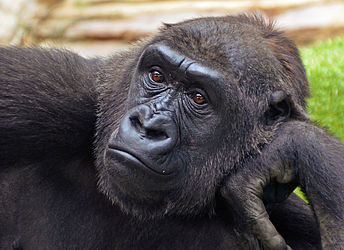
Figure \(\PageIndex{10}\) - Western Gorilla (Gorilla gorilla gorilla)
The “gentle giant” of the great apes, there are two species of Gorilla: G. gorilla (Western lowland gorilla) and G. beringei (mountain gorilla) and four subspecies: G. g. gorilla, G. g. diehli, G. b. beringei, and G. b. graueri.

Figure \(\PageIndex{11}\) - Male silverback gorilla (G. beringei)
Both of the former are critically endangered while the latter is endangered. Gorillas are sexually dimorphic and typically live in single-male, multi-female groups with a dominant male, over twelve-years-old, who has a band of silver-gray hair on its back, thus is referred to as the silverback; however, there are some multi-male, multi-female groups. Both males and females migrate from their birth groups, although female mountain gorillas tend to migrate more than female lowland gorillas, which helps to avoid inbreeding. Also in the mountain gorillas, males may stay with their natal group. When this occurs, the male is subordinate to the silverback and is called a blackback male. If the silverback dies, one of the blackbacks has the opportunity to become the new silverback. For single-male, multi-female groups, when the silverback dies the females and their offspring may disperse to join other groups or they may stay together until a new silverback transfer. Without a silverback to protect the group, infanticide can occur. The silverback maintains bonds with his females through grooming and togetherness. Conflict between silverbacks involves vocalizations and threat displays, including chest beating; rarely is actual physical conflict involved.
.jpg?revision=1)
Figure \(\PageIndex{12}\) - Mountain gorilla (G. b. beringei)
Group activity surrounds the silverback who makes all the decisions about when to travel, settling conflict, finding food resources, and defending the group. Blackbacks may assist the silverback with defense. These knuckle-walking primates, spend their days on the ground foraging for food. Females and juveniles sleep in trees, while the dominant male silverback sleeps on the ground. All gorillas are herbivores, although their food focus varies because of their habitats. Mountain gorillas (G. b. beringei) are folivores who favor bamboo. Eastern lowland gorillas (G. b. graueri) eat seasonally, focusing on fruit when available. They will also eat ants. Western lowland gorillas (G. gorilla) also focus on fruit, but also eat herbaceous vegetation, termites, and ants. Because of their diets, the home range of gorillas varies, with Western lowland gorillas having the largest range and mountain gorillas the smallest.
Females usually give birth to one offspring at a time. Infant mortality is high among mountain gorillas (up to 38%) so the mother’s care is particularly important. Males are involved in socialization of infants but do not provide care beyond protection. Infants are weaned after three or four years, providing a decent interval between births and increasing the infant’s chance of survival.
Homininae
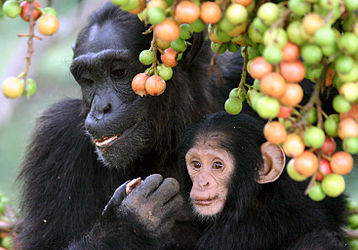
Figure \(\PageIndex{13}\) - Adult female and infant wild chimpanzees (Pan troglodytes) feeding on Ficus sur (figs)
There are two genera of extant hominins: Pan and Homo, with two species of Pan: 1) Pan troglodytes and 2) Pan paniscus, and one species of Homo: Homo sapiens.
The endangered Pan troglodytes, common chimpanzees, and Pan paniscus, bonobos are the apes most genetically similar to humans (98%+). Some researchers (Grove 2001 and Wildman et al. 2003) argue that chimpanzees are so closely related to humans that they should be genus Homo.

Figure \(\PageIndex{14}\) - Pan paniscus (note the part in the hair)
Chimpanzees live in West and Central Africa, primarily in Gabon and the Democratic Republic of Congo. They inhabit a number of habitats, including, savannas and montane, swamp, and evergreen rainforests. Bonobos are found only in the Democratic Republic of Congo in closed-canopy rainforest. Both chimps and bonobos exhibit some sexual dimorphism. Male bonobos weigh on average 86 pounds and females 63 pounds. Male chimps are slightly larger at an average of 88 to 132 pounds, and females between 70 and 104 pounds; they are sturdy and strong. As indicated by the average weights, chimpanzees are somewhat larger than bonobos. Chimpanzees have black hair and are born with pale faces that darken as they age. Males and females have beards and prominent ears. Bonobos have black fur and black faces with hair tufts on the sides of their faces and a part in the hair on their heads. While both species are quadrupedal knuckle-walkers, both can walk bipedally (although bonobos are better bipedal walkers) and bonobos also semi-brachiate.
Chimpanzees live in multi-male, multi-female groups, ranging anywhere from ten to over one hundred individuals. The core of the group is centered on an alpha male along with a small group of bonded males, although in West Africa, some groups appear to be oriented on females. The alpha male and his subordinates use physical force, display behavior, and aggression to control the community. They work together to defend the group’s territory, patrolling and chasing out unfamiliar males. The size of the group’s territory is dependent on the number of males in the group. Even though this small group of males works with the alpha, the dominant chimpanzee must constantly work to maintain his position of power.

Figure \(\PageIndex{15}\) - Mother chimpanzee (Pan troglodytes) and offspring
The strongest bond within chimpanzee social groups is between mothers and their offspring. Females generally have one baby at a time and give birth approximately every five to six years. Even though offspring are weaned by the time they are three-years old, juveniles may stay with their mother and siblings until age five through eight and help with childcare. Juvenile females leave the group at about ten-years-old, except for those groups that are centered on a core group of females. There is quite a bit of movement among group members who do not always spend the day together; they often break off into smaller groups of three to six individuals to forage.
Chimpanzees are omnivores, eating fruits, resin, bark, young leaves, tree seeds, and pith (Orcholl 2006). They incorporate over 300 species of plants in their diet. Some plants seem to be used only for medicinal purposes. Chimpanzees also incorporate animal protein in their diet, which comes from small mammals, including other primates like the colobus monkey, and insects such as termites. Male, and the occasional female, chimpanzees use cooperative techniques to hunt (watch this short video of chimps on the hunt: youtu.be/A1WBs74W4ik). At Mahale Mountain National Park, Tanzania, researchers have observed several occurrences of infanticide after failed hunts. Chimpanzees have been documented making and using spears to hunt and “fishing sticks” to acquire termites and honey (you can check out this short video about spear-wielding chimps: youtu.be/FyGxQq7jSA8). Chimpanzees have other cultural behaviors, including the hand-clasping grooming technique, using wadded up leaves as sponges, and hammers and anvils to break open nuts.

Figure \(\PageIndex{16}\) - Bonobos (Pan paniscus)
Bonobos are sometimes referred to as pygmy chimpanzees because they are slightly smaller and more slender than common chimpanzees, but the weight differences, as mentioned above, are not that great. There is less sexual dimorphism than chimps and about the same as in humans. Bonobos are efficient bipedal walkers and have been documented wading in streams while fishing, walking while carrying an armload of sugar cane, and with arms over each other’s shoulders (Orcholl 2006).
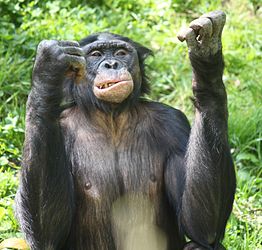
Figure \(\PageIndex{17}\) - Bonobo (Pan paniscus)
Bonobos live in fission-fusion social groups of over twenty individuals. Mother and son bonds are the strongest as sons use their mother’s rank in the social hierarchy as a means to garner favor with other high-ranking females. It is usually the highest-ranking female’s son who is alpha, but the alpha position is much different than that of the chimpanzee. The male and female alphas are almost equally dominant (Orcholl 2006). Unrelated females (juvenile females leave their natal group between ages seven to nine) work together to protect their offspring and secure resources at the expense of males. There is no core group of males that work together---after the alpha male, the hierarchy of males is murky. Also unlike chimpanzees, physical aggression is rarely used to dominate and intimidate. Intra-group conflict is settled using sexual interactions such as rump-rubbing and penis fencing among males and genital-to-genital rubbing (G-G rubbing) among females. Females wishing to join a group will use G-G rubbing with the alpha female and intercourse with the alpha male to gain admittance. While to humans, this might seem like an unusual ways to use sexual behavior, these behaviors, along with the fact that female bonobos are always receptive to sexual contact, have multiple partners, and copulate while pregnant, has eliminated infanticide from bonobo society. The fact that females leave their natal groups prevents incest. Females usually give birth to a single offspring; birth-spacing is from four to six years. Because males do not know which offspring belong to them they do not invest their time in infant care. Mothers are solely responsible for their offspring, which may help to explain why females band together.
Unlike chimpanzees, bonobos do not make and use tools, although captive bonobos have been observed using objects that are made available to them, such as tennis balls as water sponges. They do, however, exhibit emotions such as sympathy and empathy. They seem to respect other individuals’ privacy, never entering another bonobo’s sleeping nest. Like chimps, bonobos use at least one plant for medicinal purposes, specifically a leaf used when they have an intestinal parasite. Bonobos are omnivores, although about 57% of their diet is from fruit. They also eat leaves, flowers, bark, pith, roots, mushrooms, sprouts, and seeds. While bonobos do not hunt, they will opportunistically eat small mammals, insect larvae, earthworms, honey, eggs, and soil (Orcholl 20101). Finding a food source can set off a flurry of excitement and sexual interaction.
References
- Allen CJ, Evans AV, McDade MC, Schlager N, Mertz LA, Harris MS, et al., editors. Great Apes and Humans: Hominidae. In: Grzimek’s student animal life resource, Vol. 16: Mammals: Vol. 3. Detroit (MI): UXL; 2007. p. 563-577.
- Beckham EC, Cumberlidge N, Regenstein LG. Apes. In: Lerner KL, Lerner BW, editors. The Gale encyclopedia of science, 5th edition, Vol. 5. Farmington Hills (MI): Gale; 2014. p. 278-281.
- Birx HJ. Gorillas. In: Birx HJ, editor. Encyclopedia of anthropology, Vol. 3. Thousand Oaks (CA): SAGE Reference; 2006. p. 1102-1103.
- 1Cawthon Lang KA. 2005. Primate Factsheets: Gorilla (Gorilla) Behavior. Primate InfoNet [Internet] [cited 2015 Jul 02]. Available from: http://pin.primate.wisc.edu/factsheets/entry/gorilla/behav
- 2Cawthon Lang KA. 2005. Primate Factsheets: Gorilla (Gorilla) Taxonomy, Morphology, & Ecology. Primate InfoNet [Internet] [cited 2015 Jul 02]. Available from: http://pin.primate.wisc.edu/factsheets/entry/gorilla
- 3Cawthon Lang KA. 2005. Primate Factsheets: Orangutan (Pongo) Behavior. Primate InfoNet [Internet] [cited 2015 Jul 02]. Available from: http://pin.primate.wisc.edu/factsheets/entry/orangutan/behav
- 4Cawthon Lang KA. 2005. Primate Factsheets: Orangutan (Pongo) Taxonomy, Morphology, & Ecology. Primate InfoNet [Internet] [cited 2015 Jul 02]. Available from: http://pin.primate.wisc.edu/factsheets/entry/orangutan
- Cawthon Lang KA. 2006. Primate Factsheets: Chimpanzee (Pan troglodytes) Taxonomy, Morphology, & Ecology. Primate InfoNet [Internet] [cited 2015 Jul 02]. Available from: http://pin.primate.wisc.edu/factsheets/entry/chimpanzee
- 1Cawthon Lang KA. 2010. Primate Factsheets: Bonobo (Pan paniscus) Behavior. Primate InfoNet [Internet] [cited 2015 Jul 02]. Available from: http://pin.primate.wisc.edu/factsheets/entry/bonobo/behav
- 2Cawthon Lang KA. 2010. Primate Factsheets: Bonobo (Pan paniscus) Taxonomy, Morphology, & Ecology. Primate InfoNet [Internet] [cited 2015 Jul 02]. Available from: http://pin.primate.wisc.edu/factsheets/entry/bonobo/taxon
- Cumberlidge N. Gorillas. In: Lerner KL, Lerner BW, editors. The Gale encyclopedia of science, 5th edition, Vol. 4. Farmington Hills (MI): Gale; 2014. p. 2023-2024.
- Groves C. 2001. Primate taxonomy. Washington (DC): Smithsonian Institute Press.
- Groves C. Orangutans. In: Birx HJ, editor. Encyclopedia of anthropology, Vol. 4. Thousand Oaks (CA): SAGE Reference; 2006. p. 1785-1787.
- 1Hamilton, GS. Apes, Lesser. In: Birx, HJ, editor. Encyclopedia of anthropology, Vol. 1. Thousand Oaks (CA): SAGE Reference; 2006. p. 220-221.
- 2Hamilton, GS. Apes, Lesser. In: Birx, HJ, editor. Encyclopedia of anthropology, Vol. 1. Thousand Oaks (CA): SAGE Reference; 2006. p. 221-222.
- [ICUN] Internation Union for Conservation of Nature and Natural Resources [Internet]. 2015. The ICUN red list of threatened species [cited 2015 Jul 02]. Available from: www.icunredlist.org/
- Jurmain R, Kilgore L, Trevathan W. 2013. Essentials of physical anthropology, 4th edition. Belmont (CA): Wadsworth, Cengage Learning.
- O’Neill D. 1998-2014. Apes. Behavioral Sciences Department, Palomar College [Internet] [cited 2015 Jul 01]. Available from: anthro.palomar.edu/primate/prim_7.htm
- 1Orcholl JL. Bonobos. In: Birx HJ, editor. Encyclopedia of anthropology, Vol. 3. Thousand Oaks (CA): SAGE Reference; 2006. p. 389-392.
- 2Orcholl JL. Chimpanzees. In: Birx HJ, editor. Encyclopedia of anthropology, Vol. 3. Thousand Oaks (CA): SAGE Reference; 2006. p. 500-505.
- Paciulli LM, Neary JL. Gibbons. In: Birx HJ, editor. Encyclopedia of anthropology, Vol. 3. Thousand Oaks (CA): SAGE Reference; 2006. p. 1078-1079.
- Richman K. Chimpanzees. In: Lerner KL, Lerner BL, editors. The Gale encyclopedia of science, 5th edition, Vol. 2. Farmington Hills (MI): Gale; 2014. p. 905-910.
- Wildman DE, Uddin M, Guozhen L, Grossman LI, Goodman M. 2003. Implications of natural selection in shaping 99.4% nonsynonymous DNA identity between humans and chimpanzees: enlarging genus Homo. Pro Natl Acad Sci U S A 100(12): 7181-7188.


